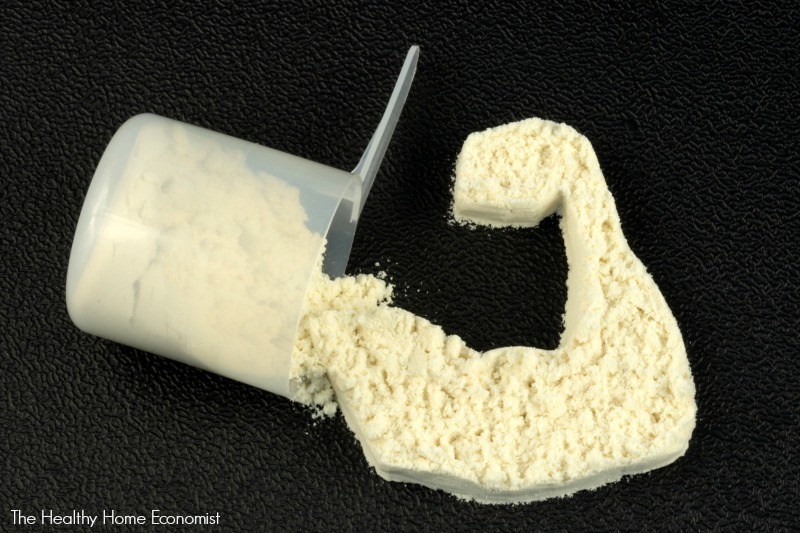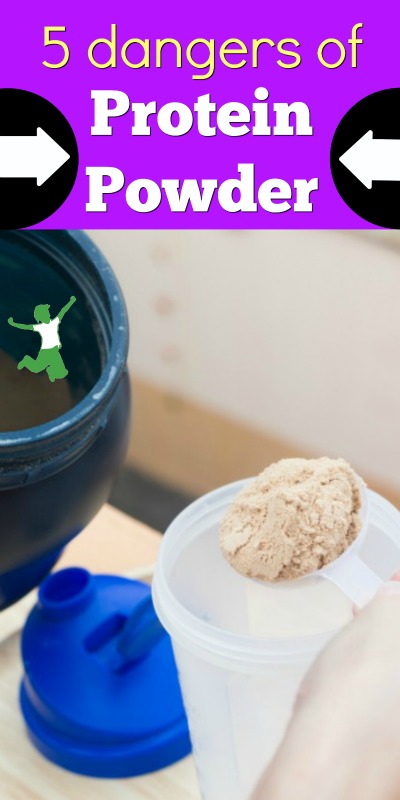The reasons why protein powder is not a health food even when organic and manufactured at low temperatures with three safe alternatives to try instead.
If there’s anything that greatly concerns me, it’s pregnant ladies drinking smoothies fortified with protein powder. Or, munching other high protein low carb snacks. These foods are used in a quest to reach the magical number of protein grams per day recommended by their OB or midwife.
When I was pregnant with my third child, I was horrified at one prenatal visit to find a basket of soy protein bars in the waiting room! This was at a birth center staffed by midwives who should have known better.
Even conventional authorities remain skeptical of this so-called health food. Kathy McManus, a registered dietician and Director of the Department of Nutrition at Brigham and Women’s Hospital, had this to say to the Harvard Health Letter:
I don’t recommend using protein powders except in a few instances, and only with supervision. (1)
This warning is especially important because it includes all brands of protein powder. It does not matter what the source of the protein is (whey, rice, soy, pea, etc.) or whether it is organic.
Dirty Secrets of Protein Powder Processing
The production of protein powder involves a shockingly high level of processing.
Think about it… making this stuff requires complete separation of the protein portion of whatever whole food is the primary source! In other words, you can’t make it in your kitchen very easily. It requires a factory to produce.
Consider this information from Sally Fallon Morell, President of the Weston A. Price Foundation sent out to all Chapter Leaders about why protein powders are not food and should be avoided:
- High-protein, low-fat results in the depletion of fat-soluble vitamins, particularly [true] Vitamin A. Ask Randy Roach, a bodybuilder who became blind using protein drinks. Filed as top secret in U.S. government files: People in Guatemala became blind when given skim milk powder as food aid.
- High protein processed foods cause autoimmune problems, fatigue, thyroid problems, cancer, etc. The most fundamental lesson of traditional cultures: they never ate lean meat.
- Proteins are very fragile– high temperature [and even low temperature] processing denatures the proteins, the body must mount an immune response.
- Lots of additives, carcinogens formed during processing (nitrates, etc.) Others added to these powdered mixtures. Tend to be high in MSG (also formed during processing).
- Where does the whey protein powder come from?? It is the waste product of conventional cheese making, confinement cows, etc. This is a similar story for other protein powders. They are a waste product from manufacturing something else. Soy protein is a waste product from making soy oil, etc.

Protein Powders During Pregnancy
While adequate protein intake is indeed important during pregnancy, getting this macronutrient via highly processed protein powders and high protein foods is a disastrous choice. This is because these same ladies that are drinking high protein smoothies and protein bars are very likely avoiding saturated fat at the same time.
A diet high in protein and low in fat rapidly depletes Vitamin A stores. Natural vitamin A from food (not beta carotene or synthetic palmitate) is necessary for optimal fetal development.
Whole foods containing large amounts of protein naturally include protective amounts of fat such as eggs and grass-fed beef. On the other hand, high protein processed foods are devoid of any fat in most cases. This makes them particularly dangerous for regular consumption.
Depletion of Vitamin A stores during pregnancy is a dangerous problem. This nutrient is critical to preventing birth defects such as cleft palate, cleft lip, major heart malformations, and hydrocephalus. Vitamin A is also the “beauty vitamin” responsible for symmetry in physical and facial features.
Vitamin A deficiency from consumption of high protein foods is not assisted by prenatal vitamins either as these worthless pills do not contain true vitamin A but instead the synthetic version, Vitamin A Palmitate or the plant-based version beta carotene. Little of this is converted to true Vitamin A.
Side Effects
Vitamin A depletion when consuming high protein processed foods is also risky for the average individual as well. Symptoms of Vitamin A depletion include:
- Heart arrhythmias
- Kidney problems
- Autoimmune disease
- Thyroid disorders
Negative calcium balance is also a risk with high protein, low-fat diets which means that more calcium is lost than what is taken in. The consequences of negative calcium balance include bone loss and nervous system disorders.
Know anyone who drinks a high protein smoothie every day for lunch who develops a bizarre neurological disorder out of the blue? I personally know several.
I’ve wondered about the stories in the news of young, healthy, vibrant male athletes, some only in high school, who inexplicably drop dead during competition. Or, seem prone to dangerous, full body cramping dehydration despite drinking plenty of water. Could these young men be eating lots of protein, much of it processed, while on a low-fat diet in order to build muscle and strength as recommended by bodybuilding magazines? Such misguided advice would rapidly deplete Vitamin A stores which could potentially lead to heart arrhythmia and sudden death.
Other Problems with High Protein Foods
Besides the depletion of Vitamin A stores, high protein processed foods contain potentially large amounts of MSG in the form of protein isolates. Separating protein from its food source during manufacturing results in the creation of MSG. It is essentially the amino acid glutamic acid gone bad. Therefore, MSG is present in high protein processed foods but it is not on the label because it is not technically added to the final product. It is created during manufacturing and therefore is conveniently unlisted on the label.
Don’t buy into the “low temperature dried” protein powder fallacy as well. Low-temperature processing and drying of protein powders is a less damaging manufacturing method. The powdering process still denatures the protein, however. Whey protein, in particular, is very fragile and should not be dried or powdered.
A good rule of thumb is that no protein powder is a safe protein powder!
Protein Powders May Increase Risk of Death
One of the most worrisome studies published in 2019 involves whey protein. Shakes made with this type of protein are typically used to quickly build muscle mass.
Whey protein contains high levels of the three branched-chain amino acids (BCAAs) leucine, valine, and isoleucine.
Researchers from the University of Sydney found that mice whose diet is high in BCCA-containing protein but relatively low in other essential nutrients can have many negative effects on long-term health and lifespan. (6)
Researchers identified that the competition between BCAAs and another amino acid – tryptophan – in the blood led to lower-than-normal serotonin levels in the brain, resulting in negative consequences to health.
3 Healthy Alternatives
Getting a healthy protein boost in smoothie recipes, safe green beverages, and other drinks (not green smoothies) without using protein powder is easier than you think!
Try powdered gelatin or collagen hydrolysate also referred to as hydrolyzed collagen peptides.
The natural gelatin from bone broth is an option too although it is not ideal for adding to smoothies in this form.
Gelatin and hydrolyzed collagen have 11 grams of protein per tablespoon. They are colloidal substances which means they attract digestive juices similar to raw foods full of enzymes. Both gelatin and peptides are helpful to the digestive process and contain a protein kick to boot!
Vetted Brands
This collagen brand and this gelatin brand are excellent. They are third-party tested to be free of toxins including glyphosate residue which shows up frequently in these types of products at unsafe levels.
Another option would be to use nutritional brewers yeast. There are several good brands with no additives or synthetics that are low temperature dried. This whole food has 8 grams of protein per serving. Be sure to avoid brands that have dangerous, synthetic folic acid listed on the label.
Be aware that even natural gelatin contains small amounts of glutamate, so if you are particularly sensitive, you may wish to choose nutritional yeast as the more suitable alternative.
References
(1) Harvard Health Letter: The Hidden Dangers of Protein Powder
(2) Muscle-building Protein Shakes May Threaten Health
(3) Adventures in Macro-Nutrient Land
(4) Vitamin A: The Forgotten Bodybuilding Nutrient
(5) Vitamin A Saga
(6) University of Sydney: Put down the protein shake: Variety of protein better for health







I think it’s better not to provide social security selection.Do they called you ans ID?
Hello, I am wondering what your thoughts are about Sunwarrior protein powder. Their blurb says ..
Sunwarrior Classic Protein uses an old world process, combining the endosperm and bran from raw sprouted whole grain brown rice, to create the first completely hypoallergenic protein, containing all essential and non-essential amino acids in a perfectly balanced profile. Sunwarrior Classic Protein has the highest amount of (non soy) raw, whole-grain sprouted, vegan protein of any product available
I am wondering about a protein that I use that is derived from eggs. It is an egg white protein that is considered the healthiest, Jay Robb Egg White Protein powder. Is it just as harmful as the others?
What is wrong with a denatured protein? Protein from eggs gets denatured when cooked, but that doesn’t mean they are harmful to eat. Your body has to break down proteins (denaturing them) in order to absorb them so what is the problem there? Also, throwing in cases of misinformed teen bodybuilders just serves as a scare tactic. Healthy individuals that are consuming proper ratios of macro-nutrients will have no issues using a powdered protein.
Thank you for this brilliant information! I did not know that gelatin and nutritional yeast were good sources of protein. What would you consider to be a serving of nutritional yeast?